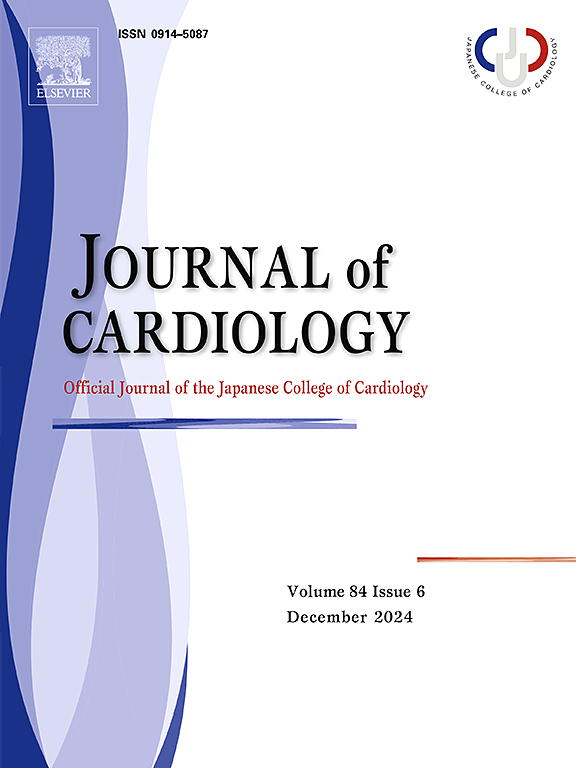Structural instability of ryanodine receptor 2 causes endoplasmic reticulum (ER) dysfunction as well as sarcoplasmic reticulum (SR) dysfunction
IF 2.6
3区 医学
Q2 CARDIAC & CARDIOVASCULAR SYSTEMS
引用次数: 0
Abstract
The type 2 ryanodine receptor (RyR2) is a giant Ca2+ (Ca)-releasing channel on the sarcoplasmic reticulum (SR) membrane, with subunits composed of 5000 amino acids constituting a homotetrameric channel. The N-terminal (1−220) and central (2300–2500) domain interactions (inter-subunit zipping interfaces) within RyR2 are located in close proximity to each other between different neighboring subunits and play an important “cornerstone” role in maintaining the tetrameric structure of RyR2. External stress such as oxidative stress causes Ca leak by destabilizing RyR2 (instability of the tetrameric structure) due to domain unzipping between N-terminal (1–220) and central (2300–2500) domains, followed by dissociation of calmodulin (CaM: binds to the RyR2 and stabilize RyR2) from RyR2. Ca leak from SR causes arrhythmias and myocardial dysfunction.
RyR2 is also present in the endoplasmic reticulum (ER), thus it is not surprising that undesired Ca release from RyR2 on the ER is closely associated with various diseases involving ER dysfunction such as neurodegenerative diseases, diabetes, metabolic dysfunction-associated steatotic liver disease, chronic kidney disease, and autoimmune diseases. Pharmacological or genetic (point mutations within RyR2 that increase CaM-RyR2 affinity: knock-in RyR2-V3599K) RyR2 structural stabilization has shown potential therapeutic effects not only for SR failure-related diseases (malignant hyperthermia, arrhythmia, and heart failure) but also for ER failure-related disease. RyR2-stabilizers may function as a panacea for aging-related diseases.

Ryanodine受体2结构不稳定导致内质网(ER)功能障碍和肌浆网(SR)功能障碍。
2型ryanodine受体(RyR2)是肌浆网(SR)膜上的一个巨大的Ca2+ (Ca)释放通道,由5000个氨基酸组成的亚基构成一个同四聚体通道。RyR2中的n端(1-220)和中央(2300-2500)结构域相互作用(亚基间压缩界面)位于不同相邻亚基之间,彼此距离很近,在维持RyR2的四聚体结构中起着重要的“基石”作用。外部压力,如氧化应激,通过破坏RyR2(四聚体结构的不稳定性)导致Ca泄漏,这是由于n端(1-220)和中心(2300-2500)结构域之间的结构域解压缩,随后钙调素(CaM:与RyR2结合并稳定RyR2)从RyR2中解离。SR的钙泄漏引起心律失常和心肌功能障碍。RyR2也存在于内质网(ER)中,因此,不希望的Ca从内质网上的RyR2释放与各种涉及内质网功能障碍的疾病密切相关,如神经退行性疾病、糖尿病、代谢功能障碍相关的脂肪变性肝病、慢性肾脏疾病和自身免疫性疾病,这并不奇怪。药理学或遗传学(RyR2内增加CaM-RyR2亲和力的点突变:敲入V3599K) RyR2结构稳定不仅对SR衰竭相关疾病(恶性高热、心律失常、心力衰竭)而且对内质网衰竭相关疾病也显示出潜在的治疗作用。ryr2稳定剂可能是治疗衰老相关疾病的灵丹妙药。
本文章由计算机程序翻译,如有差异,请以英文原文为准。
求助全文
约1分钟内获得全文
求助全文
来源期刊

Journal of cardiology
CARDIAC & CARDIOVASCULAR SYSTEMS-
CiteScore
4.90
自引率
8.00%
发文量
202
审稿时长
29 days
期刊介绍:
The official journal of the Japanese College of Cardiology is an international, English language, peer-reviewed journal publishing the latest findings in cardiovascular medicine. Journal of Cardiology (JC) aims to publish the highest-quality material covering original basic and clinical research on all aspects of cardiovascular disease. Topics covered include ischemic heart disease, cardiomyopathy, valvular heart disease, vascular disease, hypertension, arrhythmia, congenital heart disease, pharmacological and non-pharmacological treatment, new diagnostic techniques, and cardiovascular imaging. JC also publishes a selection of review articles, clinical trials, short communications, and important messages and letters to the editor.
 求助内容:
求助内容: 应助结果提醒方式:
应助结果提醒方式:


